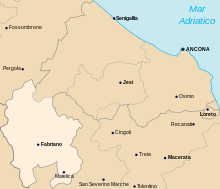History
Fabriano belongs to the medieval March of Ancona, and the modern province of Ancona. It is located approximately 56 km (35 mi) southwest and inland of the Adriatic port of Ancona, the capital of the March of Ancona. Fabriano is about 35 km (22 mi) north-northwest of Camerino by road.
Silvestro Guzzoli, the founder of the Congregation of the Sylvestrines, of the Order of Saint Benedict, is buried in the church of S. Benedict in the monastery of S. Silvestro at Monte Fano, three km. southwest of Fabriano, which he established in 1231, where Giuseppe dei Conti Atti and Ugo Laico, both Silvestrines, are also buried. [3]
On 15 November 1728, Pope Benedict XIV established the town of Fabriano as the seat of a diocese, and the collegiate church of S. Venantius [4] in Fabriano was constituted the cathedral of Fabriano. [5] The new diocese of Fabriano was united aeque principaliter [6] with the diocese of Camerino, from which its territory had been taken. Bishop Cosimo Torelli of Camerino became bishop of Camerino e Fabriano. Both dioceses continued to be directly subject to the Holy See (papacy), both politically and ecclesiastically. [7]
The city of Fabriano in 1728 had a population of around 7,000 Catholics. Camerino's 18th century population was around 4,000. Fabriano had three parishes, twelve houses of male religious and nine houses of women religious. The diocese had fifteen towns (oppida) in its jurisdiction, and several country districts. [8]
Bishop Francesco Viviani (1746–1767) held a diocesan synod for the dioceses of Camerino and Fabriano in 1748. [9]
Matelica
In 487, Bishop Equitius of Matelica was at Rome; Basilius is recorded in 499; and in 551, Bishop Florentius accompanied Pope Vigilius to Constantinople. No other bishops of the ancient see are known. [10] Until 1785, the territory of Matelica also was under the jurisdiction of Camerino. [11] The town of Matelica was under the ecclesiastical jurisdiction of the diocese of Camerino until 8 July 1785, when Pope Pius VI re-established the old Diocese of Matelica and united it aeque principaliter with Fabriano. [12]
In 1846, Bishop Francesco Faldi (1837–1858) held a synod for the diocese of Fabriano, and summoned the Chapter of the cathedral of Matelica to attend. They refused, and appealed to Rome, where the Sacred Congregation of the Council supported them against Fabriano. [13]
Bishop Macario Sorini (1883–1893) held a diocesan synod for the diocese of Fabriano in the cathedral in Fabriano on 23–25 October 1884; he held another for the diocese of Matelica on 12–14 April 1885. [14]
Reorganization of 1986
In a decree of the Second Vatican Council, it was recommended that dioceses be reorganized to take into account modern developments. [15] As part of the project begun on orders from Pope John XXIII, and continued under his successors, to reduce the number of dioceses in Italy and to rationalize their borders in terms of modern population changes and shortages of clergy, the diocese of Matelica was united to the diocese of Fabriano. The change was approved by Pope John Paul II in an audience of 27 September 1986, and by a decree of the Sacred Congregation of Bishops of the Papal Curia on 30 September 1986. Its name was to be Dioecesis Fabrianensis-Mathelicensis. The seat of the diocese was to be in Fabriano. The former cathedral in Matelica was to have the honorary title of co-cathedral, and its chapter was to be the Capitulum Concathedralis. There was to be only one episcopal curia, one seminary, one ecclesiastical tribunal; and all the clergy were to be incardinated in the diocese of Fabriano-Matelica. [16] The diocese of Matelica was completely suppressed.
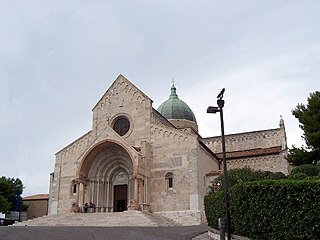
The Archdiocese of Ancona–Osimo is a Latin Church ecclesiastical territory and metropolitan see of the Catholic Church in the Marche region of Italy.

The Roman Catholic diocese of Ferentino existed until 1986, when it was united into the new diocese of Frosinone-Veroli-Ferentino.

The Diocese of Frosinone-Veroli-Ferentino is a Latin Church ecclesiastical territory or diocese of the Catholic Church in Italy. It has existed since 1986. In that year, the Diocese of Ferentino was united into the Diocese of Veroli-Frosinone, which was the name of the historic Diocese of Veroli from 1956. It is immediately exempt to the Holy See and not part of an ecclesiastical province.

The Diocese of Macerata-Tolentino-Recanati-Cingoli-Treia is a Latin diocese of the Catholic Church in Italy. It is a suffragan of the Archdiocese of Fermo.

The Diocese of Nocera Umbra was a Catholic diocese in Umbria, Italy.
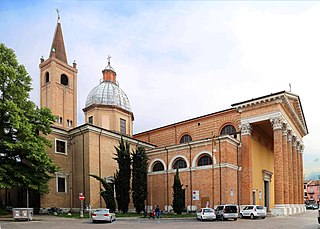
The Diocese of Forlì-Bertinoro is a Latin diocese of the Catholic Church in Romagna, Italy. Until 1986 it was known as the Diocese of Forlì, in existence perhaps from the fourth century. In that year the Diocese of Bertinoro was united to it. The diocese is suffragan to the Archdiocese of Ravenna-Cervia.

The diocese of Montefiascone was a Catholic ecclesiastical territory in Italy. It was created from the diocese of Bagnorea in 1369. In 1986 was united into the diocese of Viterbo, Acquapendente, Bagnoregio, Montefiascone, Tuscania e San Martino al Monte Cimino. The diocese was immediately subject to the Holy See (Papacy).

The Diocese of Gubbio is a Latin diocese of the Catholic Church in the province of Perugia, in Umbria, central Italy.

The Diocese of Tivoli is a Latin Church ecclesiastical territory or diocese of the Catholic Church in Latium, Italy, which has existed since the 2nd century. In 2002 territory was added to it from the Territorial Abbey of Subiaco. The diocese is immediately exempt to the Holy See.

The Diocese of Senigallia is a Latin Church diocese of the Catholic Church in the Marche, Italy. It has existed since the sixth century. It is a suffragan of the archdiocese of Ancona-Osimo.
The Catholic diocese of Sarsina was a Roman Catholic ecclesiastical territory in Emilia-Romagna, northern Italy, seated in Sarsina, in the province of Forlì, some 32 km south-southwest of Cesena. The diocese was founded in the 5th century, and was suffragan (subordinate) to the archbishop of Ravenna. The diocese existed until 1986, when it was united with the diocese of Cesena.
The Italian Catholic diocese of Bertinoro existed from 1360 to 1986. In that year it was merged with the diocese of Forlì to create the diocese of Forlì-Bertinoro.

The Diocese of San Severo is a Latin diocese of the Catholic Church in Apulia. It is a suffragan of the Archdiocese of Foggia-Bovino.
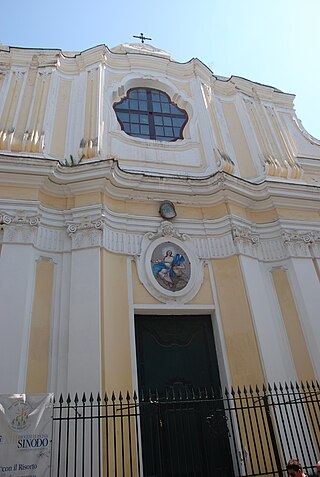
The Diocese of Ischia is a Latin diocese of the Catholic Church in Campania, southern Italy. It is a suffragan of the Archdiocese of Naples. The diocese comprises the entire island of Ischia, which contains seven communes divided into two circumscriptions. In 1743, the population was about 4,000. The city of Ischia constituted one single parish, with two religious houses of men and one of women. In 2018, the population of the town of Ischia was 20,118.

The Diocese of Pescia is a Latin diocese of the Catholic Church in Tuscany, about 41 miles (66 km) west of Florence. It is a suffragan of the Archdiocese of Pisa.

The Diocese of Sessa Aurunca is a Latin diocese of the Catholic Church in southern Italy. Since 1979 it has been a suffragan of the Archdiocese of Naples.

The Diocese of San Miniato is a Latin diocese of the Catholic Church in Tuscany. It is a suffragan of the archdiocese of Florence.
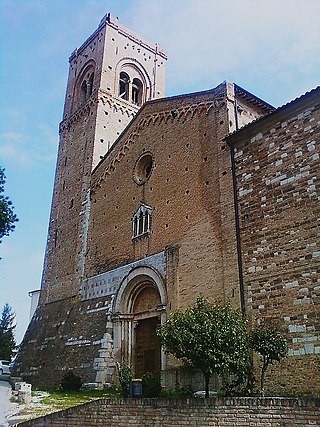
The former Italian Catholic Diocese of San Severino, in the Province of Macerata, Marche in Central Italy, existed until 1986. In that year it was united into the Archdiocese of Camerino to form the Archdiocese of Camerino-San Severino Marche.

The Italian Roman Catholic diocese of Acquapendente was an ecclesiastical territory in Lazio. The seat of the bishop was in the cathedral of Acquapendente, dedicated to the Holy Sepulchre. The diocese was established in 1649, when it was created in the place of the suppressed diocese of Castro. In 1986, along with other dioceses, it was merged into the diocese of Viterbo, Acquapendente, Bagnoregio, Montefiascone, Tuscania e San Martino al Monte Cimino.
The Diocese of Matelica was a Roman Catholic diocese located in the town of Matelica in the Province of Macerata in the Italian region of Marche.
This page is based on this
Wikipedia article Text is available under the
CC BY-SA 4.0 license; additional terms may apply.
Images, videos and audio are available under their respective licenses.

